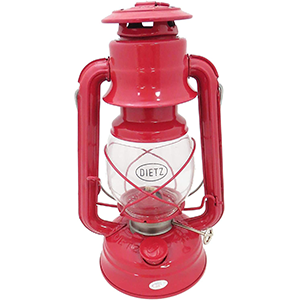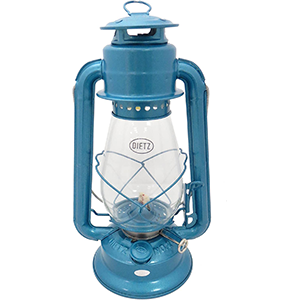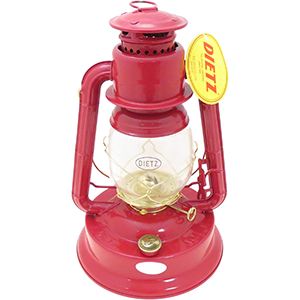When kept properly, kerosene is inexpensive and has a very long shelf life. Kerosene lanterns can therefore be an excellent lighting choice during power outages.
However, not all kerosene lamps are made equal. If you wish to have a dependable kerosene lantern for emergencies, you should be aware of the following. now, catch out on the best kerosene lantern for camping
Best Kerosene Lantern for Camping Reviews
1. Dietz Kerosene Lanterns
One of the most recognizable brands of cold-blast kerosene lamps is Dietz. They have been in operation since 1840, and antique stores frequently carry their lanterns.
The quality of the glass and aluminum in their contemporary lanterns has decreased, and they are now created in China rather than the USA. It is still a dependable kerosene light, though.
When it comes to Dietz kerosene lamps, there are several possibilities. The sizes, candlepower, burn time per tank, and wick size of each are listed in the table below. Don’t forget to check the Precision Paper Cutter reviews.
It’s unlikely that you’ll be able to prepare meals on it. It works well, though, to reheat instant soup or water for coffee or tea.
Pros:
- Several choices
- Affordable
- Classic style
Cons:
- thin metal and glass
2. Feuerhand Baby Special 276 Kerosene Lantern
Only available in one size, this Feuerhand lamp is somewhat dim. However, it is a serious kerosene lamp designed to be used, not only shown.
It is constructed from steel and has a galvanized finish. The lamp won’t rust (at least not soon! ), even if the galvanized covering will gradually becomes a gray tone. Check out the most essential Review for Hook Knife for Spoon Carving.
Dietz kerosene lights are weaker and less well manufactured than Feuerhand lanterns. You won’t have any problems with leakage, which is a problem with less expensive kerosene lanterns, because of the excellent soldering on the lantern.
Pros:
- tiny and light
- Long burn period with little fuel
- dependable construction
- Designed in Germany
- several color choices
Cons:
- a little pricey
- dim lighting
3. Coleman One Mantle Kerosene Lantern
If you’re looking for a powerful kerosene lantern, the Coleman One Mantle is an excellent option. On the maximum setting, it produces around 55 candle powder (700 lumens). The lamp shines brilliant even on the low setting.
The building is sturdy and can withstand certain bumps. The lamp is therefore quite hefty, but (nearly 5 lbs). Its layout enables replacing the mantle and removing the globe relatively simple. The globe is created in China, but the lantern is made in the United States.
A dazzling lantern’s drawback is that its fuel will run out soon. Expect a maximum burn duration of 6 to 7 hours on the low setting.
Another drawback is that using this kerosene light requires some getting used to. The alcohol in the little cup at the base of the lantern is first burned to make the kerosene burn more effectively. Additionally, this kerosene lamp has a hot blast rather than a cold one. Fuel may be drawn to the mantles using a pump.
Pros:
- really bright
- robust design
- Simple to change the brightness
- tidy burning
- Made in USA
Cons:
- Pricey
- Heavy
- utilizes a lot of gasoline
- slight learning curve
4. B&P Mason Jar Kerosene Lamp Burner
This kerosene lantern’s burner is all that is included. It includes a collar that you can screw onto a regular-mouth mason jar with a 2.75-inch diameter. Alternately, you might use the burner to swap out the one you discovered at the antique shop. A 3-inch glass chimney is also required for the burner.
You have a lot of freedom to select your base size and chimney type as a result. A 7/8″ wick fits the burner. The candle power is not stated, however typical 7/8″ wicks will produce about 12 candle power.
Pros:
- Affordable
- Choose your own chimney and foundation.
- made really good
Cons:
- No fireplace or chimney is included.
5. DNRVK Glass Kerosene Lamp
A few distinct glass kerosene lamp styles are produced under the generic trademark DNRVK. They are little, adorable, and mostly used for decoration.
But compared to most ornamental lanterns, this one functions better. You don’t have to worry about the glass fount leaking, which is an issue with metal lanterns in this price range.
The glass base has a flaw in that it is difficult to refill. To fully refill, the collar must be unscrewed. Keep in mind that you would need to wait for the collar and chimney to cool up before fuelling. If you don’t have another source of light during a power outage, this might be quite annoying.
Pros:
- Attractive
- No leaks from the glass base
- Affordable
Cons:
- Fragile
- To refuel, the body must be removed.
- very dark
- Wick adjusters are easily broken.
Kerosene Lantern Wick Size and Brightness

A kerosene lantern’s brightness is inversely proportional to the width of its wick; the broader the wick, the brighter the light. Based on wick size, the brightness of a kerosene lamp is shown below.
By bringing the wick height down, you may reduce the brightness. However, increasing the wick height won’t make the lantern brighter since it will make it burn irregularly and produce a lot of soot.
Can You Use a Kerosene Lantern to Heat a Room?
Kerosene lanterns do emit heat, therefore they can contribute to the heating of a space. The kerosene lamp will create greater heat as the wick size increases. You may get an estimate of how many BTUs a kerosene lantern generates by looking at the table below.
According to this calculator, 5,808 BTUs would be needed to raise the temperature by 15 degrees F in an average-sized living room (16 feet by 20 feet and 9 feet tall).
That indicates that to heat the space, you would require at least 7 Dietz Original kerosene lanterns. You’d be better off with a special indoor emergency heater.
Types of Kerosene Lanterns
Based on how air is brought to the flame, kerosene lanterns can be classified as either dead flame, cold blast, or hot blast.
dead flame torches
The chimneys on these lanterns are entirely open at the top. The flame is maintained by a heat airflow produced by the top aperture. Additionally, a draft produces a flame that is brighter than one produced by an open flame, such as a candle.
Despite its simplicity, this design has a few drawbacks, including the possibility of a fire if the lantern tips over. The flame will extinguish in the wind, which is another problem.
chilly-blasting lanterns
Cold-blast hurricane lights are the most prevalent. Cold air is drawn into the globe through vents at the top, where it is brought to the flame.
A second aperture near the cap also allows cold air to enter, but this air enters the tank through tubes at the side of the globe before rising to fuel the flame from below. The utilized air is then let out of the lantern through a venting cap at the top.
Firecracker Lanterns
A cold-blast lamp and a hot-blast lantern have extremely similar appearances. It also contains a hole above the globe through which fresh air may be sucked in and directed toward the flame.
On the top of the lantern, there is, however, no aperture for expelled air. Instead, the utilized hot air is pulled into tubes that travel upward from the tank and downward into the flame. The lantern can “recycle” the hot air thanks to its design.
The flame will go out if the lantern tips over, just as cold-blast lanterns. Hot-blast lanterns consume less fuel but are less light than cold-blast lanterns due to the recirculation mechanism.
They also leave behind less smell. A hot blast lantern (the Monarch #10) is produced by Dietz, however it is frequently out of stock.
Buying Antique Kerosene Lanterns
Antique shops frequently have ancient kerosene lamps for sale. Unexpectedly, several of these are of high caliber. But many of them have rusted fixtures. Fuel leaks might result from this.
You can stop these leaks if you know how to solder. However, there might be further problems with the lanterns, such as a broken wick adjuster. As a result, vintage kerosene lamps are typically only used as decorative accents.
Beware that a lot of supposedly “antique” lanterns are from the 1950s and 1960s. They were often used as decorations at that time. Even though they resemble real kerosene lamps, these are not intended for use.
What Type of Fuel Can You Use in a Kerosene Lantern?
In a kerosene lantern, only burn kerosene. But not all kerosene is created equal.
Kerosene that has been colored or used in aviation has additives that release fumes when burned, making it unsafe to use such kerosene in lanterns. The chemicals can potentially ruin your lantern by clogging the wick.
Additionally, the kerosene must have a flashpoint that is greater than 124 degrees Fahrenheit and lower than 150 degrees Fahrenheit. If not, the fire can spread out of control.
Can K-1 Kerosene Be Used in Lanterns?
Yes, K-1 kerosene may be used in lanterns. It is really affordable and simple to locate. K-1 does, however, contain certain impurities, such as sulfur.
When burned, they may emit unpleasant odors. It is only advised to burn K-1 in lanterns outside due to this. It is preferable to use additive-free, highly-purified kerosene lamp oil for indoor usage.
Keep in mind that the Klean-Strip 1-K kerosene sold by W.M. Barr & Co. Their Klean-Strip Klean Heat Kerosene Substitute, however, can be used without risk.
Can I Light a Kerosene Lantern with Lamp Oil?
Lamp oil is a vague phrase since it might mean either kerosene or paraffin oil. Kerosene lamps should only be filled with kerosene-based lamp oil.
Kerosene lamp oil tends to be more refined than conventional kerosene, which is why it burns cleaner when purchased at a gas station (such as K-1 kerosene).
The distinction between paraffin oil and kerosene
Kerosene and paraffin are both distillates of crude oil. Kerosene’s counterpart, paraffin oil, is considerably more refined. This causes it to burn more cleanly. It is substantially more viscous than kerosene and has a much higher flash point (180-200F). Only about half as brightly does paraffin burn as kerosene.
Can Paraffin Oil Be Burned in a Kerosene Lamp?
In a kerosene lantern, paraffin oil can be burned, however it is not advised. This is because paraffin won’t be drawn up by the big, flat wicks present in kerosene lanterns since it has a higher flash point and is more viscous than kerosene.
The wick will rapidly become blocked, and the flame will be unpredictable. Paraffin is “cleaner,” however it can also result in incomplete combustion, which produces more smoke.
As a result, only lamps or lanterns with tiny (less than 14″) circular wicks are advised to utilize paraffin oil.
If you must use paraffin oil, mix it with kerosene first. Use a 1:10 or 2:10 ratio (one or two parts paraffin to 10 parts kerosene).
Can Vegetable Oil Be Used in Kerosene Lanterns?
Yes, you may use a kerosene light to burn vegetable oil. However, it is not advised, just as paraffin oil.
Because it is considerably more viscous than kerosene, vegetable oil won’t be drawn up by the wick. The flame will be irregular and the wick will rapidly become blocked, producing a lot of soot and smells. Vegetable oil that has gone bad can be used for things other than lanterns.
Are Kerosene Lanterns Safe to Use Indoors?
Kerosene lanterns may be used indoors without risk, but you must only use clear kerosene. Some kerosene varieties, such aviation and jet kerosene, have additives that might cause harmful vapors to be released into the atmosphere.
Similarly, to avoid carbon monoxide poisoning while using kerosene lamps indoors, there should always be some ventilation.





